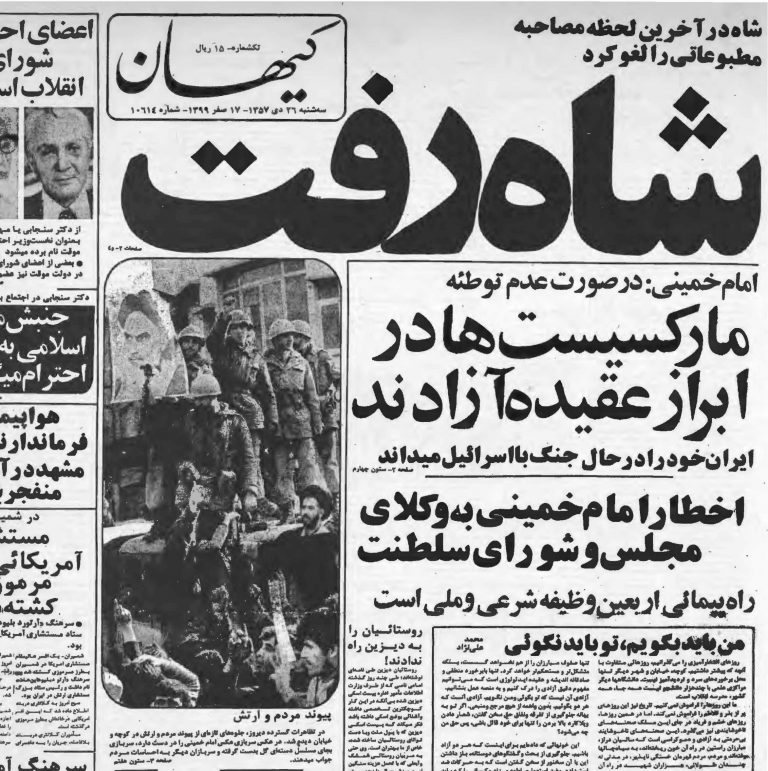Enghelab Shod: Remembering the 1979 Iranian Revolution From Carleton Centre for Public History, "Enghelab Shod: Remembering the 1979 Iranian Revolution," updated February 3, 2023.
Created by Azar Masoumi, Assistant Professor, Faculty of Arts and Social Sciences, Department of Sociology and Anthropology, Carleton University, and Ronak Ghorbani, Doctoral Candidate, Faculty of Environmental & Urban Change, York University.

Ettela’at daily newspaper Jan. 16, 1979.

Kayhan daily newspaper Jan. 16, 1979.
[Farsi for “The Revolution Happened”] Enghelab Shod is an oral history project on memories of the 1979 Iranian revolution. Our goal is to understand this grand historical event from the perspective of everyday folks who lived through it. We explore how people remember “the revolution” and with which places, dates, objects and emotions they associate these memories. Our project prioritizes documenting embodied and affective experiences as narrated through the lens of memory. This approach extends beyond common historiographies’ penchant for meta-narratives of political chronologies, and instead emphasizes the revolution as a complex lived experience that is diversely memorialized by people who live through it.
This project is based on professionally recorded oral history interviews with diasporic Iranians in Canada. In these interviews, we ask participants to describe how they learnt that “the revolution happened”: when, where, and how they began to name and recognize the ongoing political unrest as the culmination of a revolution. We also ask participants to share specific artifacts that are associated with these memories. The diverse age range of our participants provides rich insight in the experience of the revolution at various life stages, including in late childhood and adolescence.
The aim of this project is to create opportunities for intergenerational (and intercultural) communication about life amidst historical change, particularly for younger generations of Iranians for whom the “revolution” has been an abstract background to their lives. To do so, we are creating a publicly accessible online archive to showcase the recorded interviews and collected artifacts in English and Farsi. This project is informed by our own personal interest in understanding the revolution, and what it meant to live through it.
Captured below is an iconic moment in the 1979 revolution, the Shah leaving Iran. The headlines read: “Shah raft,” translated as “The Shah left” in English.
Learning from Oral Histories
In this archive you will find seven memories, collected and represented through recorded oral history interviews with diasporic Iranians in Canada. Each interview presents the story of the revolution from the perspective of one individual. In these memories, narrators tell us how they learnt that “the revolution happened.” Each memory is accompanied by one or a set of objects or artifacts that are associated with these memories. Choose one or more memories listed below to listen to and learn from.
- Simin 27 years old in 1979, remembers animated street demonstrations, a historic television broadcast, and a cherished wristwatch lost during the last days of protests.
- Shamsi 28 years old in 1979, remembers powerful oil company strikes, a tragic arson, and a car that moved her around through these turbulent years.
- Mohsen 12 years old in 1979, remembers violent street demonstrations and a sense of large-scale solidarity, school children’s self-organized protests, and a popular revolutionary song.
- Maryam 8 years old in 1979, remembers anxious and grieving grown-ups, dilemmas of loyalty, loss of normal life, and a family forever dispersed.
- Mahboubeh 25 years old in 1979, remembers English-language media reports, the hostage crisis, a painful sense of distance and disconnection, and a memorable magazine cover.
- Guiti 14 years old in 1979, remembers a historic radio broadcast, youthful revolutionary enthusiasm, walls of growing graffiti, and a book that taught her about revolutions.
- Forough in her early 20s in 1979, remembers the retreat of the army, the takeover of the national television, and a frightening escape from armed forces.

